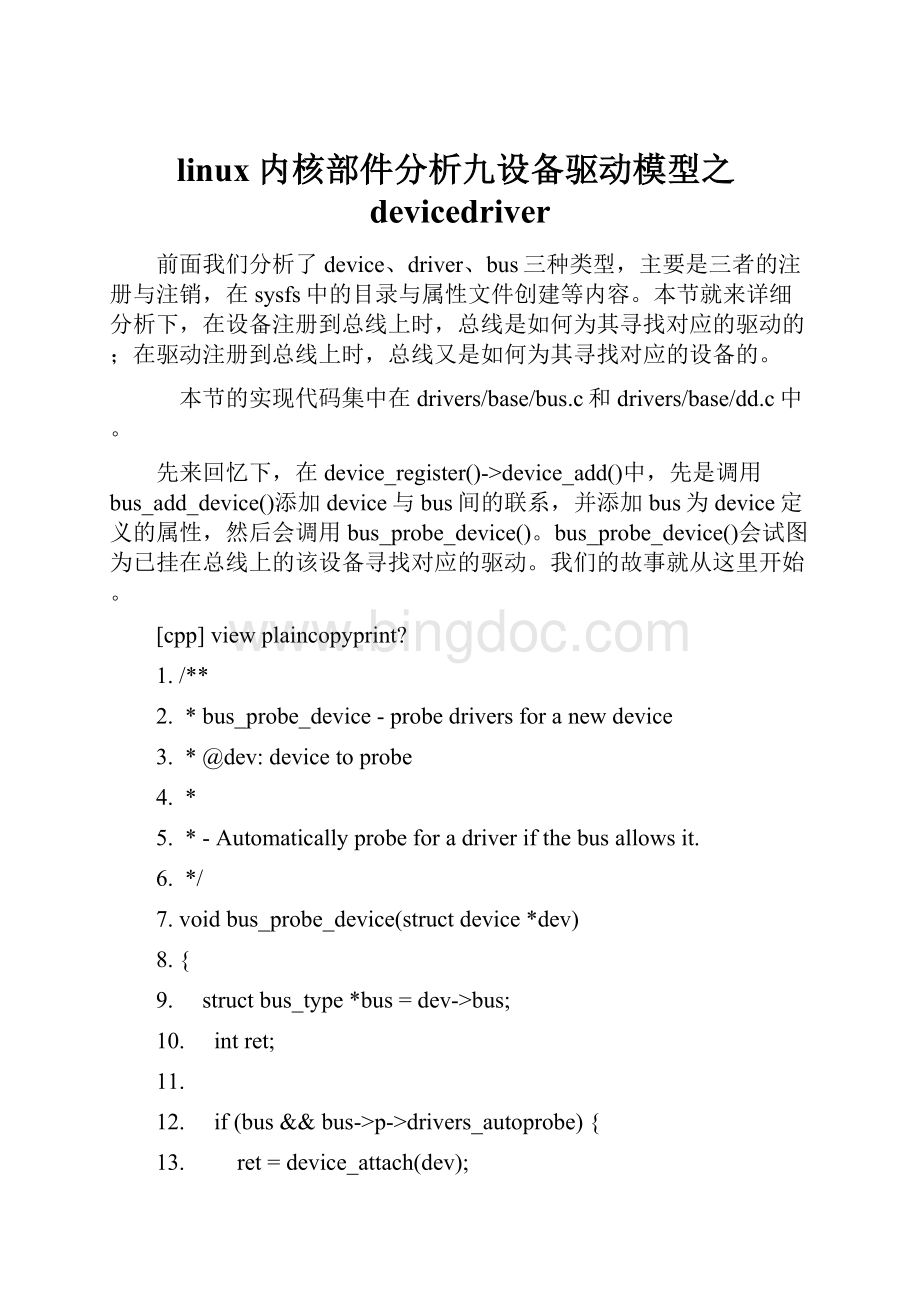linux内核部件分析九设备驱动模型之devicedriver.docx
《linux内核部件分析九设备驱动模型之devicedriver.docx》由会员分享,可在线阅读,更多相关《linux内核部件分析九设备驱动模型之devicedriver.docx(21页珍藏版)》请在冰点文库上搜索。

linux内核部件分析九设备驱动模型之devicedriver
前面我们分析了device、driver、bus三种类型,主要是三者的注册与注销,在sysfs中的目录与属性文件创建等内容。
本节就来详细分析下,在设备注册到总线上时,总线是如何为其寻找对应的驱动的;在驱动注册到总线上时,总线又是如何为其寻找对应的设备的。
本节的实现代码集中在drivers/base/bus.c和drivers/base/dd.c中。
先来回忆下,在device_register()->device_add()中,先是调用bus_add_device()添加device与bus间的联系,并添加bus为device定义的属性,然后会调用bus_probe_device()。
bus_probe_device()会试图为已挂在总线上的该设备寻找对应的驱动。
我们的故事就从这里开始。
[cpp] viewplaincopyprint?
1./**
2. * bus_probe_device - probe drivers for a new device
3. * @dev:
device to probe
4. *
5. * - Automatically probe for a driver if the bus allows it.
6. */
7.void bus_probe_device(struct device *dev)
8.{
9. struct bus_type *bus = dev->bus;
10. int ret;
11.
12. if (bus && bus->p->drivers_autoprobe) {
13. ret = device_attach(dev);
14. WARN_ON(ret < 0);
15. }
16.}
bus_probe_device()为总线上的设备寻找驱动。
它先是检查bus->p->drivers_autoprobe,看是否允许自动探测。
允许了才会调用device_attach()进行实际的寻找工作。
说到bus->p->drivers_autoprobe这个变量,它是在bus_type_private中的,在调用bus_register()前都初始化不了,在bus_register()中自动定为1。
所以,除非是用户空间通过drivers_autoprobe属性文件主动禁止,bus总是允许自动探测的,所有的bus都是如此。
[cpp] viewplaincopyprint?
1./**
2. * device_attach - try to attach device to a driver.
3. * @dev:
device.
4. *
5. * Walk the list of drivers that the bus has and call
6. * driver_probe_device() for each pair. If a compatible
7. * pair is found, break out and return.
8. *
9. * Returns 1 if the device was bound to a driver;
10. * 0 if no matching driver was found;
11. * -ENODEV if the device is not registered.
12. *
13. * When called for a USB interface, @dev->parent->sem must be held.
14. */
15.int device_attach(struct device *dev)
16.{
17. int ret = 0;
18.
19. down(&dev->sem);
20. if (dev->driver) {
21. ret = device_bind_driver(dev);
22. if (ret == 0)
23. ret = 1;
24. else {
25. dev->driver = NULL;
26. ret = 0;
27. }
28. } else {
29. pm_runtime_get_noresume(dev);
30. ret = bus_for_each_drv(dev->bus, NULL, dev, __device_attach);
31. pm_runtime_put_sync(dev);
32. }
33. up(&dev->sem);
34. return ret;
35.}
device_attach()在实际绑定之前,会用dev->sem进行加锁。
不错,dev->sem几乎就是为了在设备与驱动绑定或者解除绑定时加锁用的。
还没有看到它在其它地方被调用。
如果在调用device_attach()前就已经有了dev->driver(),就调用device_bind_driver()进行绑定,不然还要调用bus_for_each_drv()进行依次匹配。
至于pm_runtime_get_noresume之类的函数,属于电源管理部分,我们现在先忽略。
[cpp] viewplaincopyprint?
1.static void driver_bound(struct device *dev)
2.{
3. if (klist_node_attached(&dev->p->knode_driver)) {
4. printk(KERN_WARNING "%s:
device %s already bound\n",
5. __func__, kobject_name(&dev->kobj));
6. return;
7. }
8.
9. pr_debug("driver:
'%s':
%s:
bound to device '%s'\n", dev_name(dev),
10. __func__, dev->driver->name);
11.
12. if (dev->bus)
13. blocking_notifier_call_chain(&dev->bus->p->bus_notifier,
14. BUS_NOTIFY_BOUND_DRIVER, dev);
15.
16. klist_add_tail(&dev->p->knode_driver, &dev->driver->p->klist_devices);
17.}
18.
19.static int driver_sysfs_add(struct device *dev)
20.{
21. int ret;
22.
23. ret = sysfs_create_link(&dev->driver->p->kobj, &dev->kobj,
24. kobject_name(&dev->kobj));
25. if (ret == 0) {
26. ret = sysfs_create_link(&dev->kobj, &dev->driver->p->kobj,
27. "driver");
28. if (ret)
29. sysfs_remove_link(&dev->driver->p->kobj,
30. kobject_name(&dev->kobj));
31. }
32. return ret;
33.}
34.
35.static void driver_sysfs_remove(struct device *dev)
36.{
37. struct device_driver *drv = dev->driver;
38.
39. if (drv) {
40. sysfs_remove_link(&drv->p->kobj, kobject_name(&dev->kobj));
41. sysfs_remove_link(&dev->kobj, "driver");
42. }
43.}
44.
45./**
46. * device_bind_driver - bind a driver to one device.
47. * @dev:
device.
48. *
49. * Allow manual attachment of a driver to a device.
50. * Caller must have already set @dev->driver.
51. *
52. * Note that this does not modify the bus reference count
53. * nor take the bus's rwsem. Please verify those are accounted
54. * for before calling this. (It is ok to call with no other effort
55. * from a driver's probe() method.)
56. *
57. * This function must be called with @dev->sem held.
58. */
59.int device_bind_driver(struct device *dev)
60.{
61. int ret;
62.
63. ret = driver_sysfs_add(dev);
64. if (!
ret)
65. driver_bound(dev);
66. return ret;
67.}
device_bind_driver()将device与driver绑定。
它调用了两个内部函数。
其中drivers_sysfs_add()负责创建sysfs中driver和device指向对方的软链接。
还有一个与它相对的函数drivers_sysfs_remove()。
driver_bound()则实际将device加入驱动的设备链表。
因为在调用device_bind_driver()之前就已经设置过dev->driver了,所以这样就将device和driver绑定了。
只是这样好像还缺少了什么,不错,之前看到driver时曾定义了drv->probe函数,bus->probe也有类似的功能,这里只是绑定,却没有调用probe函数。
让我们回过头来,继续看如果device_attach()中没有定义dev->driver会怎么样,是用bus_for_each_drv()对bus的驱动链表进行遍历,遍历函数使用__device_attach。
[cpp] viewplaincopyprint?
1.static int __device_attach(struct device_driver *drv, void *data)
2.{
3. struct device *dev = data;
4.
5. if (!
driver_match_device(drv, dev))
6. return 0;
7.
8. return driver_probe_device(drv, dev);
9.}
不要小看了__device_attach(),就是在__device_attach()中既完成了匹配工作,又完成了绑定工作。
bus_for_each_drv()在遍历中,如果遍历函数返回值不为0,则遍历结束。
所以在__device_attach()找到并绑定了适合的驱动,就会返回1停止遍历,否则继续遍历剩余的驱动。
先来看匹配工作,这是在driver_match_device()中完成的。
[cpp] viewplaincopyprint?
1.static inline int driver_match_device(struct device_driver *drv,
2. struct device *dev)
3.{
4. return drv->bus->match ?
drv->bus->match(dev, drv) :
1;
5.}
原来driver_match_device()实际是调用drv->bus->match()来完成设备和驱动的匹配的。
其实这也是理所当然。
因为总线不同,总线规范设备、厂商、类设备等定义的规格都不同,也只有bus亲自主持匹配工作。
再具体的就只能等分析具体总线的时候了。
[cpp] viewplaincopyprint?
1.int driver_probe_device(struct device_driver *drv, struct device *dev)
2.{
3. int ret = 0;
4.
5. if (!
device_is_registered(dev))
6. return -ENODEV;
7.
8. pr_debug("bus:
'%s':
%s:
matched device %s with driver %s\n",
9. drv->bus->name, __func__, dev_name(dev), drv->name);
10.
11. pm_runtime_get_noresume(dev);
12. pm_runtime_barrier(dev);
13. ret = really_probe(dev, drv);
14. pm_runtime_put_sync(dev);
15.
16. return ret;
17.}
如果driver_match_device()匹配成功了,__device_attach()就会继续调用driver_probe_devices()完成绑定。
但driver_probe_devices()又是调用really_probe()完成的。
[cpp] viewplaincopyprint?
1.static atomic_t probe_count = ATOMIC_INIT(0);
2.static DECLARE_WAIT_QUEUE_HEAD(probe_waitqueue);
3.
4.static int really_probe(struct device *dev, struct device_driver *drv)
5.{
6. int ret = 0;
7.
8. atomic_inc(&probe_count);
9. pr_debug("bus:
'%s':
%s:
probing driver %s with device %s\n",
10. drv->bus->name, __func__, drv->name, dev_name(dev));
11. WARN_ON(!
list_empty(&dev->devres_head));
12.
13. dev->driver = drv;
14. if (driver_sysfs_add(dev)) {
15. printk(KERN_ERR "%s:
driver_sysfs_add(%s) failed\n",
16. __func__, dev_name(dev));
17. goto probe_failed;
18. }
19.
20. if (dev->bus->probe) {
21. ret = dev->bus->probe(dev);
22. if (ret)
23. goto probe_failed;
24. } else if (drv->probe) {
25. ret = drv->probe(dev);
26. if (ret)
27. goto probe_failed;
28. }
29.
30. driver_bound(dev);
31. ret = 1;
32. pr_debug("bus:
'%s':
%s:
bound device %s to driver %s\n",
33. drv->bus->name, __func__, dev_name(dev), drv->name);
34. goto done;
35.
36.probe_failed:
37. devres_release_all(dev);
38. driver_sysfs_remove(dev);
39. dev->driver = NULL;
40.
41. if (ret !
= -ENODEV && ret !
= -ENXIO) {
42. /* driver matched but the probe failed */
43. printk(KERN_WARNING
44. "%s:
probe of %s failed with error %d\n",
45. drv->name, dev_name(dev), ret);
46. }
47. /*
48. * Ignore errors returned by ->probe so that the next driver can try
49. * its luck.
50. */
51. ret = 0;
52.done:
53. atomic_dec(&probe_count);
54. wake_up(&probe_waitqueue);
55. return ret;
56.}
really_probe()完成的绑定工作和device_bind_driver()差不多,只是它还会调用bus->probe或者drv->probe中定义的probe函数。
至于在really_probe()中使用probe_count保护,最后调用wake_up(&probe_waitqueue),都是为了进行同步。
[cpp] viewplaincopyprint?
1./**
2. * driver_probe_done
3. * Determine if the probe sequence is finished or not.
4. *
5. * Should somehow figure out how to use a semaphore, not an atomic variable...
6. */
7.int driver_probe_done(void)
8.{
9. pr_debug("%s:
probe_count = %d\n", __func__,
10. atomic_read(&probe_count));
11. if (atomic_read(&probe_count))
12. return -EBUSY;
13. return 0;
14.}
15.
16./**
17. * wait_for_device_probe
18. * Wait for device probing to be completed.
19. */
20.void wait_for_device_probe(void)
21.{
22. /* wait for the known devices to complete their probing */
23. wait_event(probe_waitqueue, atomic_read(&probe_count) == 0);
24. async_synchronize_full();
25.}
driver_probe_done()检查当前是否有设备正在绑定驱动。
wait_for_device_probe()会阻塞到所有的设备绑定完驱动。
关于bus_probe_device()的过程就分析到这里,下面来看下bus_add_driver()又是怎样做的。
之前我们已经知道driver_register()把绝大部分操作都移到了bus_add_driver()中来。
其中只有一点和设备与驱动的绑定相关,就是对driver_attach()的调用。
[cpp] viewplaincopyprint?
1.int